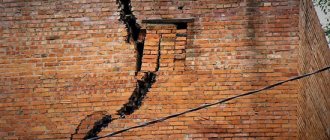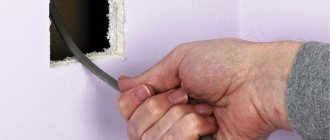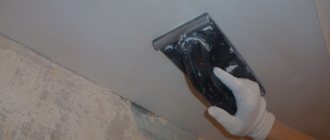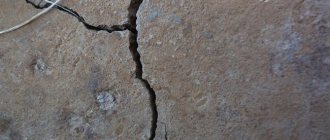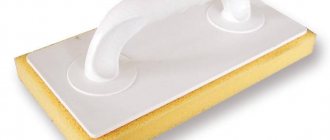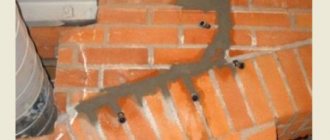0
20.11.2021
One of the important stages of repair is the identification and repair of mechanical defects. These include various holes and cracks. The nature of the appearance of such deficiencies varies. Holes may appear when laying or replacing pipes, installing an air conditioner, or mechanical impact from tools. Some materials can be damaged by mice or other rodents. In any case, it is important to know how to repair a hole in the wall.
Holes in the walls must be sealed.
Causes of holes
Page navigation
Any surface can crumble or collapse. Cracks appear in different rooms - bathrooms, hallways, kitchens. Before you try to cover up a hole in the wall, it is important to determine the reasons for its appearance.
The hole may appear due to inadequate load on the structure or as a result of errors in soil compaction. In such a situation, you need to cover up the holes only after eliminating the problems of shrinkage and strengthening the foundation. Pronounced displacements of the structure can provoke the collapse of walls and ceilings.
The formation of cracks may be the result of the influence of climatic factors. These include sharp temperature fluctuations, wind, and sunlight. The joints between the internal and external walls on the stairs and high floors of the building suffer the most.
The formation of defects may be a consequence of the concrete solution drying out after some time. Reinforced concrete structures are associated with an increased risk of through holes.
Deformations on concrete can occur when attaching shelves, cabinets, and lamps. The problem also arises when moving switches and sockets.
Thus, the key reasons for the formation of holes in the walls include the following:
- natural shrinkage of a new house;
- influence of external factors;
- replacing or moving pipes;
- installation of switches and sockets;
- laying communications through walls;
- fastening shelves, decorative elements of cabinets;
- mechanical damage.
Very rarely does a hole appear in the wall just like that, there is always some reason
Formation of cracks in a brick wall: main reasons
This question is quite common nowadays. The formation of cracks in a brick wall can be caused by a number of reasons given below:
- Freezing.
- The location of groundwater is too close.
- Insufficient depth at which the foundation was located, as a result of which a certain deformation often occurs.
- Heterogeneity causes soil subsidence.
- Too high load rates on wall surfaces, which are all kinds of floors.
- Any violation of installation technology. For example, the builder made a mistake in laying bricks, as a result of which the material was not laid with a lock, which is extremely necessary in this case.
- The mortar provided for laying bricks is of dubious quality.
- Carrying out the natural installation process during the first year of operation of the building.
What tools will you need?
Many people are interested in how to repair a hole in the wall. To begin with, it is important to choose the right tools. For this purpose the following should be used:
- brushes that have hard bristles;
- spatulas of different widths;
- brush;
- foam sponge;
- gun for working with polyurethane foam or sealant;
- perforator;
- hammer.
To seal holes in the wall, it is important to prepare the necessary tools.
When choosing a sealing method, you should take into account the characteristics of the wall material. For structures made of brick and concrete, you can use a cement mortar with the addition of plasticizers. It is permissible to seal the plastered surface with putty. It can also be plastered with Rotband or any other product. A small hole can be repaired with sealant.
When carrying out work, you should not only choose the coating composition, but also the method of its application.
So, the hole in the drywall needs to be filled with putty. The cracks in wooden walls should first be caulked and then covered with a special putty. To reinforce the hole you need a fiberglass mesh.
Most often, a cement composition is used to seal holes. It can be used externally or internally. In this case, you should choose a solution for a specific type of work.
Even an inexperienced person can mix the cement mixture
To make the mixture, it is recommended to mix sand and cement in a 3:1 ratio. You also need to add PVA and water to the composition. The result should be a medium thick consistency.
On sale you can find ready-made dry formulations that need to be diluted with water in accordance with the proportions indicated on the package.
For indoor work, lime-based compositions can be used. To make the mixture, it is recommended to take lime and sand in a ratio of 1:4. You need to add water to this composition. The solution should not be too thick or too thin.
A putty solution is considered an effective remedy. It has the consistency of a paste and is used when it is necessary to level the base and eliminate small defects.
Cement putty can be used for interior and exterior work. The main advantages of the material include its strength and moisture resistance. It is important to consider that the composition does not dry very quickly and does not have a high degree of plasticity.
Gypsum-based putties are also suitable for indoor work. They can be used in rooms with normal microclimate. The main advantage of such products is considered to be a high degree of plasticity.
The store sells ready-made formulations
Repair tools and materials
To repair a hole, you will need special tools and mixtures, and in some cases, filler: stones, crushed stone, strips of cotton fabric or gauze soaked in glue.
Before work you need to prepare:
- Repair solution: gypsum, concrete, putty. You can make the cement mixture yourself (mix part cement and 3 parts water, dilute with water until it becomes thick sour cream) or buy a ready-made one.
- Primer, wallpaper or paint.
- Sandpaper.
- A spatula, something sharp to widen the gap (a strong knife, nail or screwdriver), a sponge with water.
- Vacuum cleaner or brush to remove dust.
You may also need polyurethane foam, sealant, stones or crushed stone, and reinforcing tape.
The choice of repair solution depends on the specific situation and location. Each option has good and bad sides:
- Cement putty. Can be used to decorate walls inside and outside, easy to install yourself. Advantages include strength and moisture resistance, disadvantages include lack of plasticity and drying time.
- Gypsum putty. For indoor use only. It is quite plastic, but allows water to pass through and does not tolerate temperature changes.
- Repair mixture. Sold ready-made, suitable for indoor and outdoor use. It clings well to concrete and is resistant to temperature changes, cold, fungus and mechanical stress. However, for each damage it is necessary to choose a specific mixture - using one for all cracks will not work.
- Acrylic sealants. They do not allow moisture to pass through and are plastic, but are used only for final finishing or in small gaps; they can be applied in an exceptionally thin layer. In addition, they are significantly more expensive.
- Polyurethane foam. It can be one-component or two-component (it is necessary to connect two parts). The advantages of the first include the ability to repair deep cracks, the advantages of the second include penetration to sufficient depths, quick drying and good adhesion to concrete. Both options cause shrinkage of the material.
How to cover up a hole from dowels during repairs
Sometimes holes appear in walls as a result of drilling with a hammer drill or other tool. How can you cover up holes in the wall from dowels, screws or self-tapping screws?
For this purpose, it is recommended to do the following:
- Remove concrete debris with a vacuum cleaner.
- Moisten the cavity generously with water. For this purpose, you can use a brush or spray.
- Seal the hole in the wall with a putty knife. In this case, it is permissible to putty it or use a repair mixture.
- Apply putty in several layers with intermediate surface treatment with sandpaper. This will help achieve an even structure without deepening.
- When using a repair mixture, apply a layer of putty. This will help level the surface.
This method is suitable for eliminating a small hole in the wall - up to 50 mm. How to seal a hole in the wall from a larger dowel? A deep hole must first be filled with foam. After this, you can resort to the described technology.
The method for sealing a dowel hole depends on its size.
How to repair a large hole?
Sometimes it happens that when repairing walls, not only pieces of plaster fall out. They may be joined by broken pieces of concrete or brick. In this case, it is necessary to use additional reinforcement of the wall surface.
- Similar to the previous cases, we clean the hole from everything unnecessary.
- We drive in dowels or screw in powerful screws. If the pothole is large enough, they need to be additionally tied with wire.
- Remove debris and dust with a dry brush or vacuum cleaner.
- Wet the surface with plenty of water.
- Add broken brick or crushed stone to a standard cement-sand mortar.
- Use the resulting mixture to seal the fallen piece of the wall, let the solution sit and dry.
- If necessary, we plaster the surface of the entire wall or locally a section of the hole, then dry it and repair the cracks.
- Now you can start finishing.
Cement mortar should be applied in thin layers, allowing them to dry thoroughly. A thick layer is guaranteed to crack or fall off.
A method for eliminating large holes from a set of sockets and wires
If there are large holes left in the room from the installation of sockets, you need to do the following:
- Get rid of dust and other contaminants.
- Treat with a regular primer.
- Place brick chips or crushed stone into the large hole.
- Mix 1 part cement with 3 parts sand and dilute the resulting composition with water.
- Seal the holes with a spatula and leave for 12 hours.
- Do the final leveling and putty the walls until smooth.
At the puttying stage, it is recommended to finish the entire wall completely. Only after this can you move on to decorative cladding or wallpapering.
The hole from the sockets must be sealed with a cement-sand mixture.
Small hole
Small holes can occur from a hammered nail, dowel or other mechanical damage. It looks terrible and can cause damage to the overall structure of the wall, so it is necessary to seal the cracks in a timely manner. To do this you will need a metal spatula, mixture, screw, sandpaper and a vacuum cleaner. The sequence of work performed is as follows:
- Insert the appropriate size screw into the hole and move it in all directions. You need to achieve widening of the hole channels.
- Use a vacuum cleaner to remove any created dust.
- Apply the solution with a spatula, press it into the recess and level the surface.
- After complete drying, you need to sand it with sandpaper. Depending on what finishing material you have on the wall, seal the surface. If it might look rough, then use appliqué or something like that.
Alabaster or any type of gypsum is used as a solution. You can also use cement with sand (in a ratio of 1:3).
Holes in the ceiling after falling plaster
The easiest way is to cover the damaged area with a new layer of plaster. However, this option is not considered very good, since the hole will appear again in the near future.
To completely fix the problem, it is important to do the following:
- Before attempting to seal the hole, the damaged area should be thoroughly cleaned. It is important to do this as carefully as possible.
- Then it is necessary to treat the surface with an antifungal substance. The fact is that it is a fungal infection that most often leads to crumbling of plaster.
- At the next stage, treat the damaged area and adjacent areas with a primer layer.
- Putty the coating in 2-3 layers. This depends on the required thickness. It is important to dry each layer thoroughly.
- Rub down the ceiling and prime again.
Repairing damage to the ceiling has certain features.
Through holes
If through holes appear in the wall, it is important to take a different approach. How to cover such holes in a concrete wall? If the tool goes through, the hole must be covered on both sides.
To do this, you must first cover it with a piece of stone or brick. After this, a mixture of sand and cement should be applied to the problem area. It is first laid on one side, and then on the other.
After the solution has dried, it is recommended to apply finishing plaster. You should also be sure to sand the surface.
If there is no access to the opposite wall, the problem can be solved as follows:
- Install 4 dowels near the hole, which will become a kind of support for the stone.
- Seal the hole with a piece of stone. It should be adjusted to the size of the hole.
- Strengthen the stone. This must be done with a solution based on cement and sand. It should be mixed in a ratio of 1:3.
- After the substance has dried, level the damaged area with plaster and sand it with sandpaper.
The final treatment of the wall is done with plaster
Damage restoration methods
How to repair holes in a concrete wall and how to proceed when carrying out such work are questions, the answers to which depend on the scale of the defect and its type.
The following technologies are distinguished:
- Injection. This means that polymer compounds are literally injected in small portions into voids and cracks using special equipment. The advantage of this method is that after this the structure can serve for a long time without needing replacement or repair.
- Sealing with a special compound. This type of work assumes that the damaged section of the walls is laid with cement mortar and at the same time a polymer additive containing sulfanol or furyl alcohol, and the top layer is covered with polyurethane sealant.
- Shotcrete. This type of work is also carried out using the composition described above, but on top of it there must be a layer of a mixture of cement solution and an organic additive based on latex, resin and bitumen.
Concrete injection.
Such methods are used mainly for fairly large cracks and holes that appear, for example, during the dismantling and replacement of heating systems, etc. If we are talking about minor defects, for example, traces of nails on which pictures or shelves used to hang, then it is enough to cover the hole with cement mortar.
Cracks at joints
Many people are interested in how to fix a hole in the wall if it appears at the junction. To do this, you need to use the same approach as for walls. However, there are some differences.
The main feature is the need to expand the crack. To do this, it is increased to 6-12 mm along its entire length.
The appearance of cracks and holes in an apartment is considered a rather unpleasant problem. To cope with it, it is important to establish the nature of the damage. To seal problem areas, cement-sand mixtures, gypsum, putty, and alabaster are used.
How to make an almost invisible hole?
In order to seal such a hole, you can use any of the above materials, depending on your capabilities and the expected result.
Before you start, you need to prepare the following materials and tools:
- a long nail or something similar - you need to increase the diameter of the hole in the wall so that the material with which you will seal the hole penetrates better into the base
- vacuum cleaner – remove excess dust
- brush and water – use a damp brush to treat the hole to improve the quality of work
- repair mortar – directly for filling the hole
- spatula - for applying repair mortar
- sandpaper - for final processing of the result
If the hole in the wall is large and deep enough, your efforts will be needed much more.
After standard cleaning of the hole from dust with a vacuum cleaner and a damp brush, you need to seriously consider the issue of choosing a material. Most often, specialists use several finishing materials at once - for starting and finishing work separately. For example, construction foam is covered with finishing putty on top.
If, after the finishing material has dried, cracks appear in it, they need to be covered up again.
If the hole is quite impressive in size, then you can place a piece of brick or other material in it, and then seal it with a building mixture. This will significantly reduce the cost of finishing materials and save your time.
